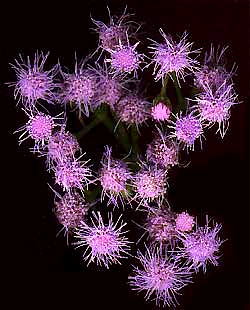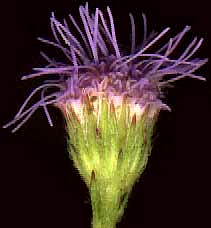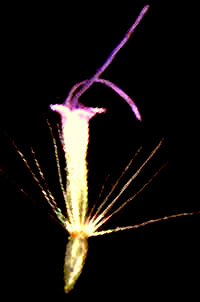
In late summer and early fall, woods, stream banks, roadsides and fields from New Jersey to Kansas south to Texas and the Gulf Coast are often graced by purplish color-splashes of the native wildflower whose flowering heads are shown at the right. That's the Blue Mistflower, Eupatorium coelestinum. Blue Mistflowers are just one species of the large genus Eupatorium. Over 41 eupatorium species are recognized, with 24 just in North America. Other eupatoriums go by such names as thoroughwort, snakeroot, boneset and Joe-Pye Weed. Several eupatorium cultivars have been developed.

Since eupatoriums are members of the Composite Family, the parts which at first glance look like flowers are actually heads composed of many special kinds of flowers called florets. The head at the left contains about 50 florets. In that picture you can see an important feature common to all eupatoriums -- no petal-like ray florets are present, only tubular disc florets. The spreading hairlike items are slender style branches arising from inside each corolla. Pollen grains germinate on the style brancches' stigmatic surfaces. When a flower head is composed only of disc florets, it is said to be discoid.

For the picture at the right the slender, green, scale-like bracts along one side of the head's greenish involucre have been removed so that the disc florets can be seen closely clustered atop a little hill-like, greenish receptacle. In most other eupatorium species the receptacle is lower, or even flat. Such a high, "conic" receptacle is a distinguishing feature for Blue Mistflower. In the same picture, notice that the cylindrical, purple-topped corollas arise from small oval, cream-colored ovaries, the future cypsela-type fruits.

At the left you can see how the cypsela-type fruit at the picture's bottom attaches to the vertical, cylindrical corolla. White, slender pappus bristles spread from atop the cypsela. When the corolla falls off and the mature cypsela is ready for dispersal, the bristles will serve as "parachutes" which catch in the wind and carry the cypsela to someplace else, where maybe the single seed inside the cypsela can germinate and form a new plant. The whole floret at the left is a little more than ¼-inch high (7 mm).
A plant very similar to Blue Mistflowers, known as Ageratum, often is grown as an ornamental garden plant. Though Ageratums at first glance are very similar to Blue Mistflowers, when you look closer you see important differences. For instance, you can see at the left that mistflowers have very conspicuous pappuses, but Ageratums have none. Mistflower plants spread by creeping rhizomes, while Ageratums do not. Also, mistflowers are native American plants, but Ageratums are introduced from the tropics.